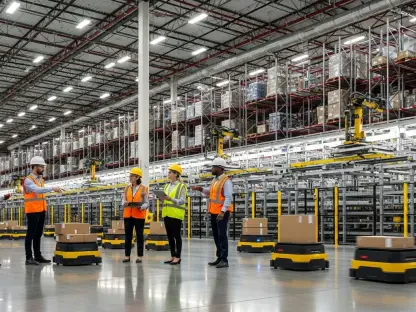In an era where artificial intelligence is increasingly influencing job roles across sectors, the urgency for developing AI fluency within the workforce is more pressing than ever. As businesses seek to leverage AI for streamlining operations and enhancing productivity, it becomes critical for human resources (HR) departments to craft comprehensive strategies that equip employees with the necessary understanding and skills to navigate this evolving landscape. The challenge lies not in transforming each employee into a data scientist but in fostering a culture where AI is integrated naturally into various roles, aiding innovation and efficiency. With AI’s potential, organizations face both opportunities and challenges; how HR navigates this will significantly impact future workforce dynamics.
The Role of HR in Advancing AI Fluency
Shifting Paradigms in Workforce Development
HR departments are increasingly tasked with embedding AI fluency into their organizational cultures as the way of work continues to evolve through constant technological advancements. This shift is crucial for preparing employees to harness AI tools effectively, and it represents an expansion of HR’s traditional role from personnel management to a pivotal player in organizational adaptability. By leading AI fluency initiatives, HR can influence not only the proficiency of individual employees but also the competitive edge of the company. Such involvement underscores HR’s transition into strategic partners within companies, charged with aligning workforce capabilities with technological innovations.
The task of cultivating AI fluency is further intensified by legitimate employee concerns over job displacement. Research indicates that approximately 37% of workers express anxiety about AI threatening their job security, emphasizing the need for HR to address these fears constructively. Educating employees on AI integration as a complement to, rather than a replacement for, human skills helps alleviate anxiety. Training programs that emphasize personal development in conjunction with AI use can transform potential dread into a positive outlook on technology. In doing so, HR supports the notion of AI as an enhancement tool rather than an adversary to existing roles.
Role-Specific Training and Collaboration
AI fluency initiatives should focus on providing role-specific training, catering to the diverse needs of employees across departments. This tailored approach ensures that AI learning is directly applicable to daily tasks, maximizing its utility within specific job functions. By collaborating with IT departments, HR can ensure coherence in the deployment of AI tools, selecting training programs that reflect both existing systems and new technologies integrated into the workplace. This strategic alignment reduces potential confusion among employees and enhances the practical application of learned AI skills.
An essential component of HR’s strategy involves regular updates and evaluations to AI training programs in response to rapid technological changes. This continuous improvement model ensures that training remains relevant, effectively contributing to overall productivity. Additionally, fostering a culture of continuous learning encourages employees to proactively seek knowledge, adapt to new tools, and refine their capabilities. By establishing adaptable learning systems, HR not only supports employees’ professional growth but also facilitates organizational resilience in the face of technological disruption.
Crafting Effective AI Literacy Programs
Building a Foundation of Confidence
To effectively navigate an AI-driven workplace, employees must cultivate practical confidence rather than solely focusing on acquiring technical skills. AI literacy programs initiated by HR should aim to demystify AI tools and foster a comfortable yet proficient use of technology. By instilling confidence, employees become empowered to explore AI possibilities, enabling them to harness its potential for optimizing work processes and augmenting their roles. Such empowerment leads to a more dynamic workforce, where innovation and problem-solving capabilities flourish alongside technological advancements.
A crucial aspect of these programs is understanding when and how to leverage AI insights while incorporating human judgment. Helping employees discern the reliability of AI outputs and the scenarios in which to prioritize human oversight over automated processes builds essential navigational skills. Training that emphasizes the integration of AI into existing workflows not only increases efficiency but also enriches decision-making processes. This approach ensures that employees remain integral to their roles, with AI acting as a supportive partner rather than an intrusive force.
Tailored Learning Approaches
Recognizing diverse learning styles among employees is vital in designing AI training programs that resonate with individuals across various levels of expertise. Offering a mix of formal mentorship, peer learning opportunities, and experimental learning environments caters to different preferences, allowing employees to engage with AI in ways that best suit their learning habits. This diversity in training methods enriches the overall learning experience, promoting a deeper understanding and more effective application of AI technologies.
Continuous support is crucial to maintaining the momentum of AI fluency initiatives. HR can facilitate ongoing access to resources and forums where employees can share experiences and insights, fostering a collaborative learning culture. Such environments encourage knowledge exchange, innovative thinking, and a sense of community, all of which are pivotal in sustaining long-term engagement with AI tools. As employees grow more accustomed to these technologies, their natural integration into everyday tasks can lead to groundbreaking improvements in workplace productivity and satisfaction.
Navigating AI in Hiring and Professional Development
Enhancing Employment Prospects
AI’s influence extends beyond workforce development into hiring practices, where it promises to democratize opportunities and promote inclusivity. By prioritizing skills and potential over traditional metrics such as educational background, AI can transform recruitment processes, enabling HR departments to identify diverse talent pools and foster a more inclusive workplace. AI-powered job postings that eliminate biased language further contribute to this effort, ensuring that candidates are evaluated fairly and equitably.
However, this democratization of hiring processes also requires careful oversight to prevent unintended biases in AI algorithms. HR must collaborate closely with IT to ensure that AI tools are aligned with ethical standards and organizational values. Regular audits and updates to recruitment algorithms can help maintain integrity and fairness, cementing AI’s role as a force for good within hiring practices. Further, by expanding access to learning and development resources through AI, organizations can break down socio-economic barriers and provide employees with opportunities to upskill, regardless of their backgrounds.
Fostering Long-term Career Growth
Strategic development efforts should emphasize the importance of cultivating soft skills in tandem with AI fluency. Skills such as communication, adaptability, and critical thinking remain beyond the current capabilities of AI, representing areas where human contribution is irreplaceable. By focusing on these skills, HR can ensure that employees are not only proficient with technology but also prepared to thrive in collaborative, creative, and problem-solving environments.
Moreover, entry-level roles, traditionally seen as a foundation for professional growth, should be enhanced rather than eliminated due to AI integration. Employing AI tools can help newcomers acclimate to workplace environments, preparing them for more complex tasks as they progress in their careers. Through initiatives such as mentorship programs and peer networks, employees at all levels can glean valuable insights and support, creating a robust ecosystem for personal and professional development. Ultimately, this approach ensures a workforce that is equipped not only for present challenges but poised for future success.
Overcoming Challenges and Embracing Change
Addressing Leadership Concerns
Despite the clear benefits of AI fluency initiatives, leadership resistance remains a significant obstacle, often fueled by fears of complexity and cost. Leaders may hesitate to invest in comprehensive AI training due to concerns about the transformation’s expense and uncertainty around measurable outcomes. Yet, successful examples abound where technology-driven initiatives have facilitated remarkable growth and innovation. To sway leadership, HR needs to showcase tangible benefits and align AI strategies with organizational goals, emphasizing long-term gains over immediate costs.
In addressing these concerns, communication and transparency are key. By keeping leadership informed and involved throughout the implementation process, HR can foster a sense of shared commitment to AI initiatives. Encouraging leadership to personally participate in AI fluency programs can also bridge the understanding gap, creating advocates within the organization. This joint ownership ensures that organizational culture evolves alongside technological adoption rather than in response to it.
Bridging the Skill Gap
The skill gap presents another hurdle in achieving seamless AI integration, necessitating strategic interventions to prepare employees adequately. HR’s role involves illustrating that technological shifts are opportunities for growth rather than impediments. Demonstrating the transformative potential of AI through case studies and pilot projects helps demystify technology, encouraging employee engagement and enthusiasm.
Creating an adaptable workforce requires a commitment to lifelong learning, which involves continuous upskilling and reskilling initiatives. By investing in training that evolves with technological advancements, organizations can ensure that employees remain relevant and competitive in their respective fields. Additionally, fostering a culture of openness to change helps employees embrace new ways of working, enabling them to adapt swiftly and confidently to AI-driven transformations. This proactive approach guarantees that employees are not only prepared for current roles but are also equipped to seize future opportunities.
Looking Ahead: A Future-Ready Workforce
As work environments continually transform due to technological advances, HR departments are increasingly expected to foster an AI-friendly culture within organizations. This critical shift prepares employees to use AI tools efficiently, extending HR’s role from basic employee management to being essential in organizational adaptability. By spearheading AI fluency, HR not only boosts employee skills but also enhances the company’s competitive standing. This shift highlights HR’s evolving status into strategic partners responsible for synchronizing workforce expertise with technological breakthroughs.
Moreover, the mission of nurturing AI literacy is complicated by valid employee apprehensions about job security. Studies show that around 37% of workers fear AI may jeopardize their positions, prompting HR to address these concerns proactively. By educating employees on how AI can complement rather than replace human skills, HR helps ease these worries. Training initiatives that merge personal growth with AI usage can shift employees’ perspective from fear to optimism, framing AI as a valuable tool rather than a threat to existing jobs.









